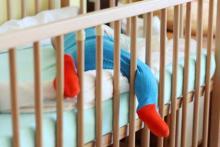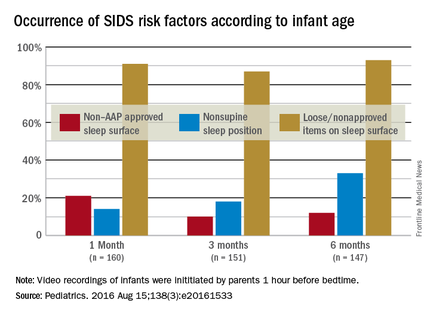Most infants sleep in environments with risk factors for sudden infant death syndrome (SIDS), even when parents know that they are being recorded on cameras placed in their homes, according to a study published online Aug. 15 by Pediatrics.
Most infants slept with objects that were loose or not approved by the American Academy of Pediatrics: 91% at 1 month of age, 87% at 3 months, and 93% at 6 months. Items included loose bedding, bumper pads, pillows or cushions, and stuffed animals. Three 6-month-olds were allowed to sleep with pets, and two slept with loose cords or electrical wire, reported Erich K. Batra, MD, and his associates at the Penn State University, Hershey.
Smaller percentages of infants slept on nonapproved surfaces such as adult beds, car seats, or swings: 21% at 1 month of age, 10% at 3 months, and 12% at 6 months. Fourteen percent of infants were placed in a nonsupine position at 1 month, 18% at 3 months, and 33% at 6 months of age, Dr. Batra and his associates said (Pediatrics. 2016 Aug 15;138[3]:e20161533).
The results of the study “suggest that current public education and health care provider guidance related to safe infant sleep are not being carefully adhered to, even in a relatively educated, affluent patient population,” they wrote.
Almost 70% of mothers and fathers were college graduates, and the median family income was $60,000. Of the 167 infants enrolled in the study, 160 had videos available at 1 month of age, 151 had 3-month videos, and 147 had 6-month videos. At each of the three time points, “video recordings were initiated by parents 1 hour before the start of bedtime. Recordings continued throughout the night until the infant was fully awake in the morning,” Dr. Batra and his associates noted.
The investigators said that they had no conflicts to disclose, and the study was funded by the National Institutes of Health.



